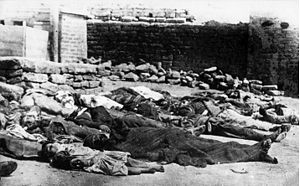March Days
| March Days | |||||||
|---|---|---|---|---|---|---|---|
| Part of Russian Civil War | |||||||
 Azerbaijani victims in Baku |
|||||||
|
|||||||
| Belligerents | |||||||
|
|
|
||||||
| Commanders and leaders | |||||||
| Stepan Shahumyan | |||||||
| Strength | |||||||
|
Bolsheviks 6,000 regular troops, Russian Fleet gunboats ARF 4,000 militiamen |
10,000 troops and militiamen | ||||||
| Casualties and losses | |||||||
| 2,500 ARF soldiers | between 3,000 to 12,000 Azerbaijanis and other Muslims including civilians massacred | ||||||
The March Days, or March Events, refers to inter-ethnic strife and massacres of between 3,000 to 12,000Azerbaijanis and other Muslims that took place between 30 March – 2 April 1918 in the city of Baku and adjacent areas of the Baku Governorate of the Transcaucasian Democratic Federative Republic.
Facilitated by a political power struggle between Bolsheviks with support of the Armenian Revolutionary Federation (Dashnaktsutiun) on one side and the Azerbaijani Musavat Party on another, the events led to the suppression of Muslim revolt by Bolshevik and Dashnak forces and establishment of the short-lived Baku Commune in April 1918.
Azerbaijan officially refers to the March Days as soyqırım ('genocide'). Other sources interpret the March events in the context of civil war unrest.
Following the February Revolution, a Special Transcaucasian Committee, including Armenian, Azerbaijani and Georgian representatives, was established to administer parts of the South Caucasus under the control of the Russian Provisional Government. After the October Revolution, on 11 November 1917, this committee was replaced by the Transcaucasian Commissariat, also known as the Sejm, with headquarters in Tiflis. The Sejm opposed Bolshevism and sought separation of the South Caucasus from Bolshevik Russia. To prevent that, on 13 November 1917, a group of Bolsheviks and Left Socialist-Revolutionaries (SR) proclaimed the Baku Soviet, a governing body which assumed power over the territory of Baku Governorate under the leadership of Bolshevik Stepan Shahumyan. Although the Baku Soviet included Azerbaijanis and Armenians who were neither Bolsheviks nor necessarily sympathetic towards Bolshevik ideas, the two nationalist parties and members of the Sejm ― the Musavat and Armenian Revolutionary Federation ― refused to recognize its authority. The Baku-based Musavat dominated the Muslim National Councils (MNCs), a representative body which eventually formed the first Parliament of the Azerbaijan Democratic Republic (ADR). Mammad Hasan Hajinski chaired the Temporary Executive Committee for the MNCs, while Mammed Amin Rasulzade, Alimardan Topchubashev, Fatali Khan Khoyski and other prominent political figures were among the 44 Azerbaijani delegates to the Sejm. Meanwhile, the ARF, which was established in Tiflis, formed a 27-member Armenian delegation to the Sejm. The leader of the Baku Soviet, Shahumyan, kept contacts with ARF and viewed it as a source of support for eliminating Musavat influence in Baku. It is noteworthy that during the March Days of 1918, one of the ARF founders, Stepan Zorian, was present in Baku.
...
Wikipedia
